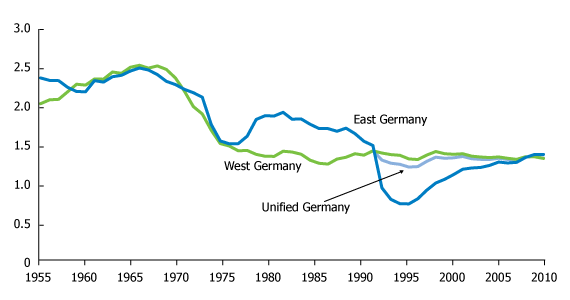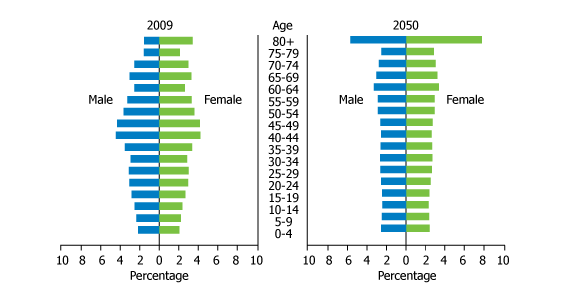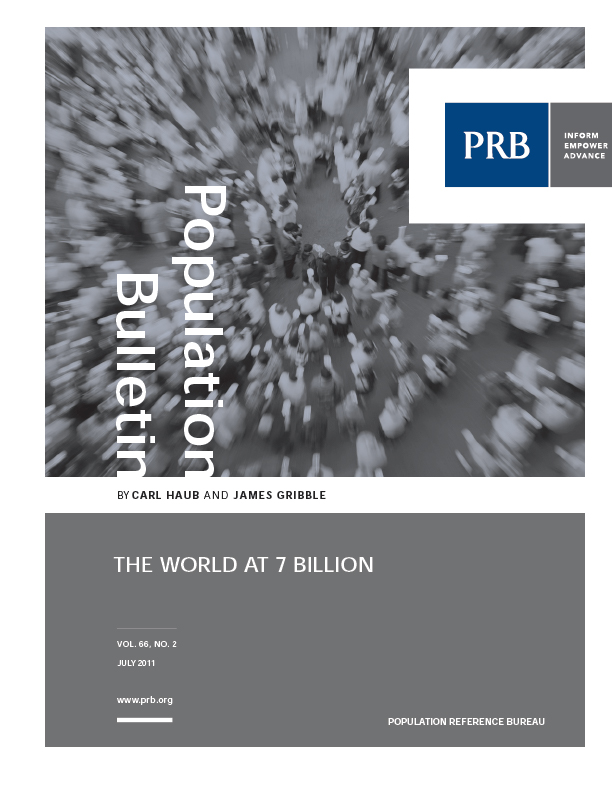
Germany: Beyond the Transition's End
Date
July 18, 2011
Author
Focus Areas
This article is taken from the Population Bulletin: The World At 7 Billion, which looks at the four phases of the demographic transition as descriptive of past and future population growth. Four countries are highlighted to illustrate each phase and its implications for human well-being.
Germany’s recovery from the devastation of World War II is often called an “economic miracle” because its economy is now Europe’s largest. Immigration has been an important part of the country’s modern demographic history.
Labor shortages led to a guest-worker program, which began bringing workers to West Germany from countries such as Greece, Italy, Spain, Turkey, and Yugoslavia in the late 1950s. Rather than return to their homelands, however, many of these workers brought their families to Germany. From 1960 to the early 1980s, net immigration averaged several hundred thousand per year, peaking at more than 500,000 in 1969 and 1970. Following Germany’s reunification in 1990, a new flow of migrants arrived: ethnic Germans who had been trapped behind the Iron Curtain. In 1992, net immigration neared 800,000. There was concern at the time that some of these migrants were not true ethnic Germans, but were economic migrants seeking a better life in the West. At the end of 2009, 19 percent of Germany’s population had what the German Federal Statistical Office calls a “migrant” background, which includes immigrants since 1950 and their offspring.
Germany is a dramatic example of the fourth phase of demographic transition: Countries with low or very low birth and death rates represent almost half, or 46 percent, of the world’s population.
Overview
Germany’s population stands at an estimated 81.8 million in mid-2011, the largest country in the European Union by a good margin. But that total is down from 82.3 million at the end of 2006. Germany’s principal demographic concerns today are its very low birth rate and the lack of social and cultural integration of its migrant population. Recently, Chancellor Angela Merkel stated that integration was “not working.”
Figure 1
Total Fertility Rate in Germany, 1955-2010
 Source: German Federal Statistical Office.
Source: German Federal Statistical Office.
In 1964, births exceeded deaths by 486,985, the highest postwar surplus. By 1972, deaths in Germany exceeded births by 64,032, and deaths have surpassed births every year since. In 2010, the difference between births and deaths stood at -180,833. Only a positive balance of net immigration has forestalled a much more rapid population decline. As a member of the European Union (EU), Germany must also abide by the Schengen Agreement of 1985 whereby the EU has no border controls. Member states do have the right to impose certain restrictions, however. In 1995, the agreement was in force in the 25 member states. There has been some resistance to including new member states from eastern and southern Europe in the passport-free zone. The EU is now debating the Schengen status of new members Bulgaria and Romania.
Population and Policies
The fourth phase of the demographic transition is often described as an extended period of near demographic equilibrium, with fertility near the replacement level of about 2.1 children per woman. In the majority of industrialized countries, fertility fell quite rapidly throughout the late 1960s and early 1970s, a transformation that was to alter demographic prospects in many countries in unforeseen ways. In the United States, fertility fell from 2.9 children per woman in 1965 to a record low of 1.7 in 1976. Germany reached a TFR of 1.7 in 1970. But while the U.S. fertility rate slowly rebounded to 2.1 in 1990 (and has remained close to that ever since), the German fertility rate did not rebound, and today is much lower, at 1.4.
Fertility in the former East and West Germany followed a very similar path up to the mid-1970s. But East Germany, under Communist rule, instituted a number of pronatalist measures such as family allowances, maternity leave, and child care subsidies. Fertility rose until the economic disruption after the country’s reunification and the subsequent out-migration from East Germany to the West.
Figure 2
Age and Sex Structure of Germany, 2009 and 2050
 Sources: For 2009: German Federal Statistical Office, Statistical Yearbook 2010. For 2050: United Nations Population Division, World Population Prospects: The 2010 Revision (2011).
Sources: For 2009: German Federal Statistical Office, Statistical Yearbook 2010. For 2050: United Nations Population Division, World Population Prospects: The 2010 Revision (2011).
In western Germany, however, little was done to reverse the trend in low fertility. Fertility has remained below 1.5 children per woman since 1975, and at times considerably below. Obstacles to increasing the birth rate are similar to other low-fertility countries, particularly people’s lack of confidence in their economic future. But there are several other factors. Day care centers usually close at 1 p.m., a burden on the growing number of two-earner families. Social attitudes tend to disfavor leaving one’s child in the care of someone else for the entire day. Mothers who do leave their children all day are often considered to be “raven mothers” (Rabenmutter) because a raven abandons her young at an early age. But this attitude may be slowly changing with growing acknowledgment of a birth rate crisis. Some day care centers now sport Ganztags! signs (all-day day care). The government took little direct action until well after 2000, despite growing concern over the diminished number of young people and its effect on supporting pension programs and virtually free health care, particularly for the elderly.
To try to increase the birth rate, the government gives 184 euros monthly for the first and second child, 190 euros for the third, and 215 for the fourth until each child turns 18 (or 25 if still pursuing an education). Maternity leave spans 14 weeks, six weeks prior to the birth and eight weeks afterward—with a minimum benefit paid of 13 euros per day. Finally, a monthly minimum of 300 euros is allocated for care of a newborn but can rise to 1,800 euros or 67 percent of one’s prior salary. This is paid for 14 months with the stipulation that one parent must use the benefit for two months, a feature that ensures that fathers will take part in child care. The additional expense has put a strain on the national budget and has had little effect on birth rates. But only a few countries in the industrialized world have seen significant increases in birth rates from these kinds of family benefits—notably Russia and the Canadian province of Quebec.
Challenges
To date, efforts to raise fertility in Germany have not been successful. In two Eurobarometer surveys, respondents were asked about their “personal ideal” number of children. In 2001, German women ages 15 to 24 said 1.8 children; in 2006, they said 2.0. In contrast, in France the answer was 2.6 for both survey years. Answers to questions on ideal numbers of children, however, are nearly always much higher than fertility actually achieved in developed countries. In the 2001 survey, among German women ages 18 to 34, nearly 17 percent gave “none” as their ideal and 9 percent said “one,” percentages far higher than other EU countries.
Projections from the National Statistical Office assume that, if there is a rise in fertility, it will be quite modest. With an increase to a fertility rate of 1.6 children and annual net immigration of 200,000, Germany’s population would decrease to 74.5 million in 2060 with 31 percent of the population ages 65 and older. Should fertility remain at 1.4 children and immigration amount to 100,000 per year, the 2060 population would decline to 64.7 million, with 34 percent ages 65 and over. Given the stable trend in fertility over the last 35 years and the lack of success of pronatalist programs, population decline and continued aging appear to describe the country’s future quite well.
Previous:
World Population Growing at Record Speed
Phase 1: Uganda: At the Beginning of the Demographic Transition
Phase 2: Guatemala: Beyond the Early Phase of the Demographic Transition
Phase 3: India: On the Path to Replacement-Level Fertility?

 ">
">